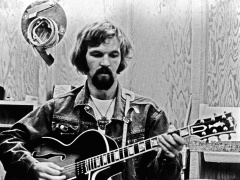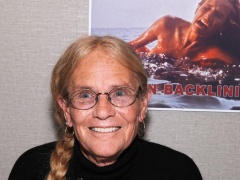
David Lindley, a virtuoso guitarist and multi-instrumentalist best known to many for his work with Jackson Browne, as well as a recording and touring artist in his own right, died Friday at age 78.
No cause of death was immediately given. The musician had been known to have been ailing for some time. A family member posted late last year that Lindley had been repeatedly hospitalized for kidney issues, pneumonia and influenza; a fundraiser that had been recently set up for Lindley and his family said his medical issues “seem to have begun with a terrible bout of Long Covid.”
“The loss of David Lindley is a huge one,” tweeted Jason Isbell. “Without his influence my music would sound completely different. I was genuinely obsessed with his playing from the first time I heard it. The man was a giant.”
Lindley’s tenure with Browne includes all of that artist’s seminal works from 1973-80, and several more Browne albums beyond that, with his most famous soloing being heard on the title track of the “Running on Empty” album, along with a falsetto vocal on the same record’s “Stay.”
So sorry to hear the great David Lindley has passed away. The world has lost a brilliant musician.
— Stephen King (@StephenKing) March 3, 2023
“That final cadenza on that one live version of Jackson Browne’’s ‘Running on Empty’ is the greatest recorded live song ending EVER,” tweeted Living Colour guitarist Vernon Reid upon seeing news of Lindley’s death.
He is also known for a series of collaborations with Ry Cooder that began with the “Jazz” and “Bop Till You Drop” albums in 1979-80 and continued into Cooder’s 1980s soundtrack era. Other longstanding associations include mulitple albums in which he backed Linda Ronstadt, Warren Zevon, David Crosby, Graham Nash and Rod Stewart in the ’70s and ’80s.
Additional session work included playing with Emmylou Harris, James Taylor, Bruce Springsteen, Kenny Loggins, Leonard Cohen, Dolly Parton, Little Feat, the Bangles, John Prine, Shawn Colvin, Amy Grant, America, Bread, Eddie Money, Bob Dylan, Ben Harper, Aaron Neville, Terry Reid, David Blue and many others.
Lindley also had a longstanding career as a frontman, first with the band Kaleidoscope, which issued four albums in 1967-70, then in the 1980s as the leader of what he called a “party-rock” group, El Rayo-X, with whom he had a minor hit with the classic song “Mercury Blues” in 1981.
In later years, Lindley did less studio work and took to doing solo shows under his own name, sometimes focusing on his signature guitar playing but eventually drifting more toward less conventional instruments like the oud, a 12-string Persian cousin to the lute.
One more thing about the late great #DavidLindley in time for tomorrow's #WeirdPride day. He was so obviously brilliant musically he didn't have to care at all about looking "cute." So he wore the most bizarre and garish shirts possible under that sly grin and rat's nest of hair. pic.twitter/VlVo0GSL37
— Steve Silberman (@stevesilberman) March 3, 2023
After starting out as a bluegrass player with the group the Dry City Scat Band, Lindley had his first band of real renown with Kaleidoscope, which Jimmy Page was said to have described while he was still with the Yardbirds as “my favorite band of all time — my ideal band.”
Lindley started out playing five-string banjo, growing up in San Marino, Calif. — playing literally in the closet. “My mom and dad were disturbed by their son, the hillbilly musician,” Lindley laughed in an interview. “It was very much a classical music family, so what did I get interested in? Hillbilly music, dammit!” Ultimately, though, “I just had this burning interest in any instrument that had strings on it.” His early influences ranged from Duane Eddy to the Kingston Trio to Segovia, with no small assist from an uncle who was a concert pianist playing at the Hollywood Bowl, not to mention a father who listened to classical Indian folk music.
His attention turned back to the guitar. “I also went to a party in Balboa and there was a guy there with a guitar just strumming chords, you know, and there were all these girls hanging around him,” he said in a conversation with ToneQuest. “Then a light bulb came on… Hey, hey… Lindley… come on… wake the fuck up! Check this out! So I did, and boy, did it work.”
Lindley’s multi-instrumental abilities soon made him a popular session player because I played everything. I can remember having conversations about that with everybody. You want to be in a band? Oh, oh, they already have a five-string player. Well, let’s see… I’ll play the fiddle.” Still, he said, “I didn’t learn it so I could work. I explored all different kinds of stuff and I would take techniques from one instrument and put them on another. And I started listening to singers, and that’s where the lap steel came in. The lap steel was my way of singing— of playing a vocal.”
Browne recalled first hearing of Lindley while visiting the Topanga Canyon Banjo and Fiddle Contest, where his future bandmate had been made a judge after winning “about five times in a row.” He told Ben Harper in an interview he didn’t actually get to see Lindley play until he saw his band Kaleidescope perform at the Ash Grove club in Santa Monica, where he was impressed by the musician “playing harp-guitar and electric instruments, but also really steeped in folk music.”
Although fans most associated him with the slide guitar, Lindley had little interest in meeting those expectations of what instrument he should be playing. In the 2005 ToneQuest interview, he said that he was playing slide guitar for the Blind Boys of Alabama at the time, and would bring it out for sessions, but when he went out to do his own shows, his interests had moved on elsewhere, to more exotic instruments. “You know, there was a time when I was playing 5-string banjo and I would sit in with different bands and play with my own band, and I was known as a 5-string banjo player. Then I’d be out doing something else and they would ask me when I was going to play the 5-string banjo again. ‘Well, I’m doing this now’,” he recalled. “I’m obsessed with the oud now, and I’m obsessed with the technique of playing the saz. I have a saz now that is strung up like it is supposed to be with nine strings and it sounds like an entire orchestra.”
He went out on a band tour with El Rayo X for a half-dozen shows in 2003, but otherwise in later years had mostly stuck with solo gigs, when it came to headlining. The economics of full-band tours were not working for him, but also, “It’s a lot easier going out by myself, and I also get more out of it because I get to play the stuff I’m into rather than recreating what I used to do.” Expressing a preference for acoustic concerts, he added, “A lot of the people in my audience can’t go to loud concerts anymore… Now we have 23-year-old kids with the hearing of an 80-year-old man.”
Lindley’s interest in the oud dated back to his late ’60s work with the band Kaleidoscope. ““It was the sound, and the technique,” he said of his fascination with the oud in an interview with the Santa Barbara Independent. “There are no frets, so you can play all these microtonal scales that you find in Persian Turkish and Middle Eastern music.”
Other side trips in Lindley’s wild ride through different musical styles included recording six albums of Malagasy music Madagascar with guitarist Henry Kaiser, one of which earned a Grammy nomination, and two records with Jordanian musician Hani Nasser.
It’s so sad to hear of David Lindley’s passing. He was a giant among musicians. Always his unique sound and style gave him away in one note. My thoughts are with his family.
— Peter Frampton (@peterframpton) March 4, 2023
Lindley had settled back in Claremont, Calif., near the Claremont Folk Center, which had been one of his touchstones growing up in San Marino. He is survived by his wife, Joan Darrow, and daughter, Rosanne.
No words can describe the loss of David Lindley. He changed the game for all of us. Rest in peace sir. pic.twitter/eEqMaQM99v
— Joe Bonamassa (Official) (@JBONAMASSA) March 4, 2023






